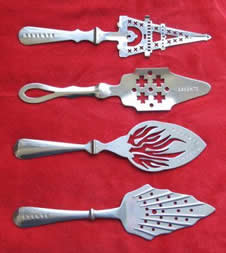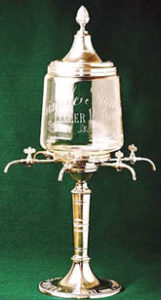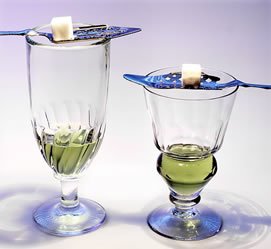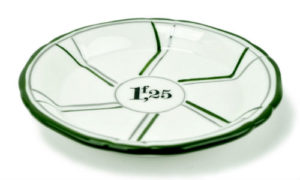Absinthiana are the tools, accessories, and accoutrements of the absinthe ritual. Ranging from ornate spoons made of precious metals to unique hand-blown serving and water glasses, absinthe paraphernalia tends to be quality crafted and produced by cottage manufacturers known for their love and devotion to making la fee verte an enjoyable drink the world round.
The essential absinthe preparation calls for an absinthe spoon, a water carafe or drip, and an absinthe glass. Absinthe trimmings come in both traditional and nouveaux modern styles, and while you can enjoy absinthe just as well out of a paper cup, we do recommend springing for an absinthe kit unique to your tastes once you’ve established a prolonged enjoyment for The Green Lady.
Absinthe Spoons

Absinthe spoons are used for dissolving a cube of sugar into your absinthe pour, for the trademark absinthe louche. Absinthe spoons come in a variety of shapes and sizes, with a few distinct similarities that you will find in any absinthe spoon.
The absinthe spoon will almost always have a notch at the joint between handle and bowl where the spoon rests against the top of your absinthe glass. Bowls of absinthe spoons are usually flat, or with a slight concavity that should sit flush against opposite rims of an absinthe glass.
Traditional absinthe spoons, i.e. those produced prior to the wormwood ban of 1914, were often stamped or marked with various brand advertisements and considered souvenir barware. Other, more rare and valuable spoons, are considered not only works of art for their intricacy but also revered on the order of jewels for the precious metals used to forge them.
Modern absinthe spoons tend to be more sleek and minimal, though they do retain some aspects of traditional absinthe spoons. Modern absinthe spoons use the same “flat bowl” design; as well also the grille slit openings for dissolving sugar found in traditional absinthe spoons. These features are universal, necessitated by the desire for a milky absinthe louche in the favored pour.
Absinthe Water Drips
 In the absinthe heyday of the late 1800’s, taverns and cafes hired “absinthe professionals” (much like wine sommeliers) to recommend and provide table service for the ritualized absinthe pour. For the absinthe pour, drops of water dissolve sugar through the absinthe spoon into the absinthe glass. Whether you prefer a glass carafe for an individual pour or a fountain for your absinthe party purposes, an abundance of options are available for absinthe water drips.
In the absinthe heyday of the late 1800’s, taverns and cafes hired “absinthe professionals” (much like wine sommeliers) to recommend and provide table service for the ritualized absinthe pour. For the absinthe pour, drops of water dissolve sugar through the absinthe spoon into the absinthe glass. Whether you prefer a glass carafe for an individual pour or a fountain for your absinthe party purposes, an abundance of options are available for absinthe water drips.
Traditional absinthe pours are the glass carafe, of which you will find many modern options as well as treasured antique pieces. Carafes generally hold anywhere from a half liter to two liters of water, and can be used for one-at-a-time individual pours.
Absinthe fountains contain water in a central chamber with a number of spigots extending toward the drinks of a party. The fountain chamber is usually made of a metal such as brass rather than glass. The spigots of an absinthe fountain may be fixed to the chamber and composed of the same metal, or they may be flexible, resembling the arms of a tobacco hookah. Absinthe fountain pours are generally regulated on the interior to drip rather than truly pour or spout. Absinthe fountains are perfect for special occasions and absinthe parties, and can accommodate as many as ten first-time or sophisticated absinthe drinkers.
You may find modern absinthe fountains in brushed steel as opposed to brass or more traditional metals. The composition of modern absinthe fountains varies from traditional fountains in many ways as there are no true standards other than the essence of the drip. The important point is to find a unique piece that you will treasure and use for as long as you enjoy absinthe.
Absinthe Glasses
 Absinthe glasses are the true pièce de résistance of an absinthe drinker’s inventory. A fine absinthe glass will provide years of enjoyment for the absinthe drinker.
Absinthe glasses are the true pièce de résistance of an absinthe drinker’s inventory. A fine absinthe glass will provide years of enjoyment for the absinthe drinker.
At the early stages of absinthe’s popularity, it was served in normal barware. Over time, innovative producers of glassworks crafted a glass exclusive to the absinthe ritual: a stout, fluted piece with a reservoir above the short stem and a demarcation indicating the height of a pour. The reservoir in an absinthe glass is its most important feature, as it not only provides a clear reference for the ratio of a pour but also acts as a catalyst for the majestic louche that occurs when water, sugar, and absinthe mix in the glass.
Some absinthe glasses are called Brouille glasses. Brouille glasses have a container for ice and sugar atop the glass, negating the need for a drip. The water chamber atop a Brouille glass allows the ice and sugar to melt together and drip into the absinthe glass together for a distinctive individual pour.
In the best of absinthe glasses, the composition of the glass highlights the emerald green of the absinthe’s color and iridescence. When shopping for antique or traditional absinthe glasses, shop to your tastes but know that the more ornate the design of an absinthe glass, the more likely it is that the glass has exceptional value. Modern absinthe glasses tend to retain the stocky, short-stem build of traditional absinthe glasses, and almost always feature a reservoir of some type, ranging from bulbous to a subtle pinch in the flute.
Absinthe Coasters (or saucers)
Traditional absinthe coasters more resemble what we consider saucers (or sous verres) . Also known as French tip trays, they are widely considered a status symbol that indicates the price of Absinthe. These saucers are typically made of porcelain and are sized to perfectly fit the bottom of the glass.
From a practical perspective, the saucer shape protected wood tables from the wet glass damaging it. The color was used so that waiters would know the cost of the drink. In a way, this unique “coaster” doubled as a bill for patrons.
For the less sophisticated, a standard drink coaster with artwork works well too. Especially in modern times when we no longer need a colored saucer to add up a bill. These modern coasters can be found in wood, leather, and paper. They can be purchased through online stores such as Society6 and Etsy. Or if you prefer, utilize your own artistic talents to create a custom drink coaster to feature your own style. Absinthe is the perfect drink to show your creative side.
Purchasing Advice
Always consider your own personal tastes when shopping for absinthiana. Due to the niche status of the cottage industry producing absinthe paraphernalia, most pieces are of a certain standard of quality you won’t find in other barware, but unfortunately this means that unique pieces come and go in the market much faster compared to more common items, such as wine glasses.
Most of all, enjoy. Absinthe’s growing popularity means that you will have many opportunities to share this matchless drink and sophisticated ritual with friends for years to come. Bon aperitif!